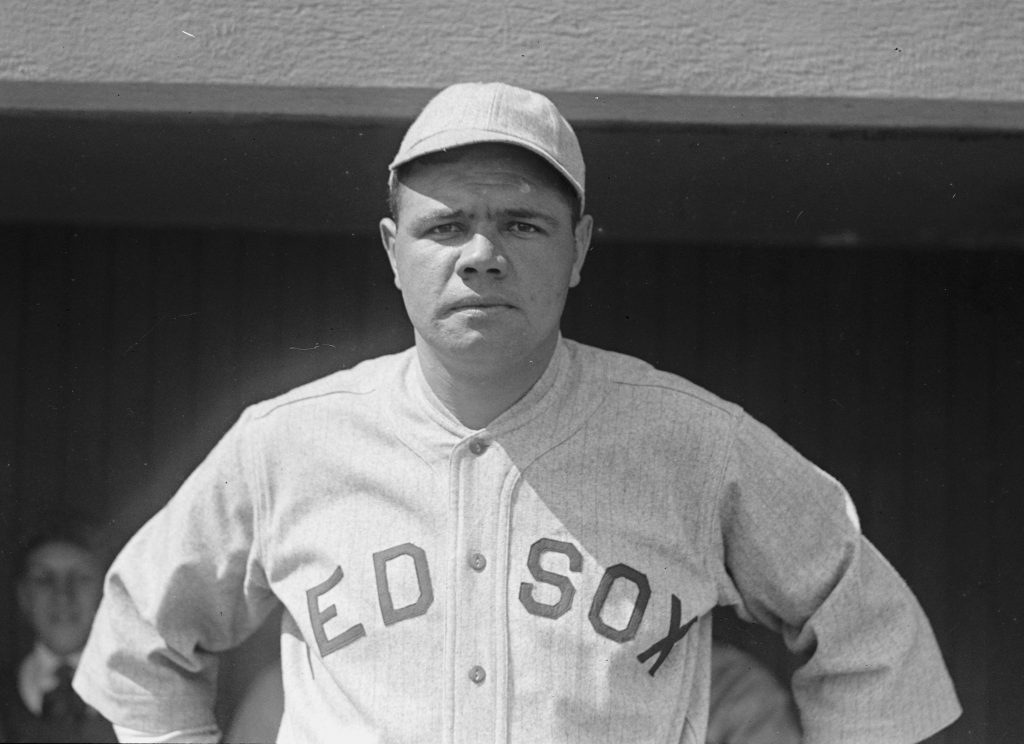The Great Bambino, The Babe, Sultan of Swat, The Big Fellow—you’ve probably heard of him. Babe Ruth, one of the greatest baseball players to ever live, was born George Herman Ruth Jr. in Pigtown, Maryland and was the son of Katherine Schamberger and George Ruth Herman Sr. Babe was known to be a rowdy child. It is rumored that the Babe threw tomatoes at police officers while they were hard at work. Due to his constant trouble making, Babe’s parents sent him off to St. Mary’s Industrial School in Baltimore, Maryland, where The Babe fell in love with baseball. Brother Mathias taught Babe how to throw, catch, and hit while he was at St. Mary’s; Mathias was a brother in the Catholic Church who taught children at St. Mary’s. Not after long, the Babe became an incredible ball player with the help of Brother Mathias, and later went on to play for the Boston Red Sox. What? You thought he played for the Yankees, right? He did, but his career began with the Boston Red Sox.1 Babe Ruth began his first season on the Red Sox in July of 1914. The Babe became a star, hitting twenty-nine home runs in the 1919 season with the Red Sox.2

Now this is where something terrible happens… Red Sox owner, Harry Frazee, sells the best player on the team to their rivals, the Yankees. In addition to being the Red Sox owner, Frazee was also a Broadway producer, and he used the money he made from selling Babe Ruth to produce one of his plays. Babe Ruth was worth a lot of money; in fact, the Red Sox sold him for $125,000! But the money did not even go back into the organization. Frazee continued this broken baseball business while selling Boston’s finest talent up until 1921, when he sold the Red Sox to Ed Barrow.2 This created the longest, most brutal curse in baseball history. Getting rid of your best players, selling them to your rival team, and receiving tons of money for a Broadway play… now that is just asking for a curse. As soon as Babe Ruth left the Red Sox things began to turn sour for the Red Sox organization. Babe Ruth was playing the best baseball of his life for the Yankees, and the Red Sox were certainly not winning games without him.4 Red Sox fans became disgusted with the organization, and the team lost many of its supporters over time.
Losing became a bad habit that the Red Sox could not seem to shake. In 1986, the Curse of the Great Bambino dramatically broke the hearts of all Red Sox fans. That year the Red Sox finally made it to the World Series, after almost seventy years. Playing against the New York Mets, the Red Sox overcame all statistical predictions and went on the play a remarkable series. In Game 6, the game went into extra innings. In the top of the tenth inning, Boston scored two runs, bringing them into the lead. With two outs against them, the Red Sox were one out away from being the World Series Champions. Suddenly, the Mets got two singles, bringing the tying runner to third. The Red Sox manager pulled pitcher Roger Clemens, and brought in their best closer, Bob Stanley, to finish the game.2 The count was 2-2 when Stanley threw a wild pitch, allowing the tying run to score and advance the other runners on base. The next pitch Stanley threw ended up being a weak ground ball hit to the first baseman, Bill Buckner.6 It was a routine play that Buckner, who was very consistent, missed… the ball went right through his legs, causing the winning run to score. If you’ve ever heard the phrase “pull a Buckner,” now you know what that means! The Red Sox lost Game 6, and they had been only two strikes away from winning the World Series; a greater force seemed to be holding the Red Sox back from winning the 1986 World Series. The Red Sox then lost Game 7 against the Mets, which was blamed on the curse.7 Game 7 was determined a loss in every fan’s eyes after the fifth inning, when the Mets secured their lead with a two-run homerun. Red Sox fans began to think that the curse was more real than ever. They were one pitch away from winning a world series, and one pitch away from ending sixty-eight years of frustration.8 The losing continued, and subsequent seasons only got worse.
Eighteen years later, in the 2004 season, the Red Sox started to show promise again. They started winning.2 The 2004 team eventually made it to the American League Championship Series against the Yankees. This time the Red Sox had one of the best teams in its history. Everyone on this team played their part in this series. The first three games of the series were discouraging for Red Sox fans, for the Red Sox lost to the Yankees all three times, allowing them only one more game to win to go onto the World Series. Many of the Red Sox players started motivating others by saying “don’t let us win at 8 tonight, if they let us win tonight we have Pedro Martinez coming in hot tomorrow,” “if there is a group of idiots that can do it, it’s us.”2 The Red Sox did not make this series easy on themselves, and they refused to get swept by their rivals. Game 4, bottom of the 9th inning, down by a run, Kevin Millar gets walked, allowing the Red Sox one last chance to beat the Yankees. The Red Sox put a pinch runner in for Millar, Dave Roberts, one of the speediest guys on the team, in order for him to steal second. Roberts almost got picked off twice, but finally stole second. He was safe!2 Red Sox fans began believing in their team. The next batter hits a line drive up the middle, scoring Roberts and tying up the game 4-4. Now to extra innings. Big Papi, David Ortiz, comes up in the bottom of the 12th inning and hits a walk-off homer!2 The Red Sox beat all odds, and finally win Game 4. But the Series is never over until it is truly over. The Red Sox were determined to win the next three games in order to prove the world wrong. In Game 5, the Yankees start out strong, leading the game by 2 runs, but then, in the bottom of the 8th inning, Big Papi steps up to the plate, once again hits a bomb over the tremendous green monster, resulting in the Red Sox being only down by one run.13 The Red Sox later tie up the game in the bottom of the 8th inning. The curse started to show its power in the top of the 9th inning, when the Yankees began hitting, the Red Sox were making errors, and the baseball gods were not in their favor. Luckily, the Red Sox made it out of the top of the 9th inning scoreless. Heading in to the bottom of the 9th Big Papi again steps up to plate hitting a line drive walk off to center field.2 David Ortiz has now come in clutch this series in dire need, twice! The baseball gods seem to finally be working in favor of the Red Sox, leading them to Game 6—Game 6 was one of the most passionate baseball games ever played.

The Red Sox continued their series slogan “why not us” in order to motivate their fans and players.2 Curt Schilling, who had just received an ankle surgery, was on the mound tonight, giving all Red Sox fans the inspiration to persevere through these last two games. Schilling fed off of the hatred of the Yankee fans, and started out very strong. Schilling did his job as a pitcher, and the offense was hitting for their injured pitcher, leading 4-0. Later throughout Game 6, Schilling’s sock became soaked in blood, and his ankle was starting to fester.2 Schilling began to limp back to the dugout, and he finished the 7th inning strong and was then pulled. Schilling made history that night, pitching with an injured bloody ankle. He left Yankee stadium shocked, and Red Sox fans inspired. The baseball gods were back and helping the Red Sox with controversial calls. The Red Sox go on winning Game 6 due to the heroic performance of Curt Schilling. His passion for the game was shown that night in Yankee Stadium.2
Finally, going into Game 7, the final game of the series, it was anybody’s ball game. Big Papi yet again brings the Red Sox into a lead 2-0 due to a major long ball home-run. In the 2nd inning, Johnny Damon hits a grand slam over the centerfield wall, allowing the Red Sox to have a 6-run security cushion early in the game.2 In the bottom of the 6th inning, the Red Sox put in pitcher Pedro Martinez, and Yankee fans began to shout, “who’s your daddy?” in order to taunt Martinez. Martinez pushed through the negativity, and finished the game 8-1 as American League Champions!2 This was the first time in sports history for a baseball team to come back to win a three-game deficit. Now off to the World Series against the St. Louis Cardinals, winning in an easy four games, finally ending the curse of the Great Bambino, after eighty-six years.

- Cynthia Rose, The Babe Ruth Story (Detroit: Gale, 2004), 692-694. ↵
- St. James Encyclopedia of Popular Culture, 2013, s.v. “Boston Red Sox,” by Steve Meyer. ↵
- St. James Encyclopedia of Popular Culture, 2013, s.v. “Boston Red Sox,” by Steve Meyer. ↵
- Edward M. Scahill, “Did Babe Ruth Have a Comparative Advantage as a Pitcher?,” The Journal of Economic Education, no. 4 (Autumn 1990): 404. ↵
- St. James Encyclopedia of Popular Culture, 2013, s.v. “Boston Red Sox,” by Steve Meyer. ↵
- Cynthia Rose, They Were Just One Pitch Away (Detroit: Gale, 2004), 642. ↵
- Cynthia Rose, They Were Just One Pitch Away (Detroit: Gale, 2004), 644. ↵
- Cynthia Rose, They Were Just One Pitch Away (Detroit: Gale, 2004), 645. ↵
- St. James Encyclopedia of Popular Culture, 2013, s.v. “Boston Red Sox,” by Steve Meyer. ↵
- St. James Encyclopedia of Popular Culture, 2013, s.v. “Boston Red Sox,” by Steve Meyer. ↵
- St. James Encyclopedia of Popular Culture, 2013, s.v. “Boston Red Sox,” by Steve Meyer. ↵
- St. James Encyclopedia of Popular Culture, 2013, s.v. “Boston Red Sox,” by Steve Meyer. ↵
- The green monster is a unique green wall in left field that is significantly taller than all of the other parts of the fence, and very few players are able to hit over this incredibly tall wall. ↵
- St. James Encyclopedia of Popular Culture, 2013, s.v. “Boston Red Sox,” by Steve Meyer. ↵
- St. James Encyclopedia of Popular Culture, 2013, s.v. “Boston Red Sox,” by Steve Meyer. ↵
- St. James Encyclopedia of Popular Culture, 2013, s.v. “Boston Red Sox,” by Steve Meyer. ↵
- St. James Encyclopedia of Popular Culture, 2013, s.v. “Boston Red Sox,” by Steve Meyer. ↵
- St. James Encyclopedia of Popular Culture, 2013, s.v. “Boston Red Sox,” by Steve Meyer. ↵
- St. James Encyclopedia of Popular Culture, 2013, s.v. “Boston Red Sox,” by Steve Meyer. ↵




58 comments
Didier Cadena
I was unfamiliar to the “Curse of the Great Gambino”, so it was really interesting to read about. I enjoyed the structure of the article, because it made it fun to read. I was not aware of how Frazee would sell his best players to fund his Broadway plays, making him seem like an extremely selfish person. The article does a great job of putting all of the information used and still make it engaging to read.
Marlene Lozano
I am not a huge baseball fan but before reading this article I knew of Babe Ruth and the “Curse of the Great Gambino” but never the full story behind him or the curse. I find it surprising that the Red Socks sold Babe even though he was one of their best players. The come back that the Red Socks made was amazing and obviously legendary.
Maricela Guerra
Wow again another cure in game six of a series, what is up with all these curses that are happening with the game sixes. How is it possible that these great teams are losing with these simple mistakes. Seeing how 2004 went it seems like the curse would never lift. But to finally after eighty six years later they win the title breaking the curse which is pretty amazing.
Tyler Thompson
My dad is a huge Red Sox’s fan, and he remembers when he was little when the Yankee’s traded Babe Ruth, and he said that it was mind blowing. The author did an amazing job with describing this event, and describing the alleged curse that he put on his former team, this article was very interesting.
Miranda Alamilla
The comeback of the Red Sox. What a great story. I thought it was kind of ironic how Curt Schilling was injured during the game and his sock got all bloody and no one said anything about that in conjunction to the Red Sox name. It could have quite possibly been what ended all superstitions. The classic underdog, but undoubtedly, a great moment in history for the Red Sox.
Carlos Sandoval
I am a huge Red Socks fan so of course I had to read this. It must have been really hard to go through all those losses and see the guy that got sold, smashing records. The first time I heard of the curse was when I was younger and I was watching “Sandlot”. I did research on that and what exactly it was, so being a Red Socks fan I easily hated the Yankees. I believe that the game of baseball has some rich culture and it is much more than just a game.
Jasmine Jaramillo
Before reading this article I didn’t know much about Babe Ruth except that he was a very good baseball player. I think it was cool that his love of baseball came from the school he was sent to for being a rowdy child. I also find it very interesting that his team change affected the Red Sox’s so much. It makes me wonder if it was all psychological or if there was really a cure. This article did a great job of talking about the struggles the Red Sox’s had to go through to win the World Champion title.
Monica Avila
Babe Ruth is a legend in baseball history, and the fact that the Red Sox sold him to the Yankees is unbelievable. My family is quite invested in baseball and softball, and yet I’ve never heard of the infamous “Curse of the Great Bambino”. It is truly inspiring that the Red Sox were able to overcome all odds, defeat the “Curse”, and restore their glory by winning 2004 World Series.
Benjamin Arreguin
In my latino household, sports are a way of connecting to family, and meeting new people. Growing up around baseball, football, and soccer, baseball was the sport we were most passionate about. Babe Ruth was someone we used to idolize in our neighborhood, but we knew nothing about who he was, and how the curse was said to have started. This article answered a few questions I grew up curious about, and made me realize how influential a great athlete can be.
Christopher King
As a huge baseball fan, this may be one of the greatest World Series I have ever watched. The Curse of the Great Bambino was something I had believed in for so long and reading this article brought back memories of watching that game. The bloody sock is now in a museum and without Schilling in game 6 they would have lost. What an amazing series and team.